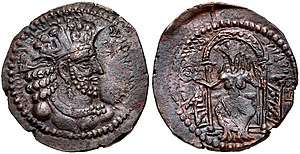Ardashir I Kushanshah
Ardashir I Kushanshah was the first Kushanshah of the Kushano-Sasanian Kingdom from 233 to 245. He was succeeded by Peroz I Kushanshah.
| Ardashir I Kushanshah | |
|---|---|
 Coin of Ardashir I Kushanshah, Marw mint | |
| Kushanshah of the Kushano-Sasanian Kingdom | |
| Reign | 233–245 |
| Successor | Peroz I Kushanshah |
| Died | 245 |
| Religion | Zoroastrianism |
Name
Ardashir is the Middle Persian form of the Old Persian Ṛtaxšira (also spelled Artaxšaçā, meaning "whose reign is through truth").[1][2] The Latin variant of the name is Artaxerxes.[1] Three kings of the Achaemenid Empire were known to have the same name.[1]
Reign
"Kushano-Sasanian" is a historiographic term used by modern scholars when referring to a dynasty of monarchs who supplanted the Kushan Empire in the Tukharistan region, and ultimately in both Kabulistan and Gandhara as well.[3] According to the historian Khodadad Rezakhani, the dynasty was seemingly a young branch of the House of Sasan, and perhaps a offspring of one of the Sasanian King of Kings.[3] It was founded in 233 by Ardashir I Kushanshah after his appointment by the first Sasanian King of Kings, Ardashir I (r. 224–242).[4][5] The Kushano-Sasanians, in the same manner as the Kushans, used the title of Kushanshah ("Kushan King"), thus demonstrating a continuum with their predecessors.[3]
The coins of Ardashir I Kushanshah had the Bactrian legend AP∆AÞΟPΟ KΟÞANΟ ÞAΟ, "Ardashir, the Kushan Shah".[6] Some of his coins also had a Pahlavi legend on the reverse reading mzdysn bgy arthštr RBA kwšan MLK "The Mazda-worshipping lord Ardashir the Great Kushan Shah".[6] The reverse of his Bactrian-written coins depicted the goddess Anahita, whilst the ones written in Pahlavi depicted Mithra.[7] Several of Ardashir I Kushanshah's coins have been found together with coins of the Kushan ruler Vasishka, suggesting a level of interaction between the two rulers.[6]
References
- Schmitt 1986, pp. 654-655.
- Wiesehöfer 1986, pp. 371-376.
- Rezakhani 2017, p. 72.
- Rezakhani 2017, pp. 72-74, 77.
- Wiesehöfer 1986, pp. 371–376.
- Daryaee & Rezakhani 2017, p. 204.
- Rezakhani 2017, p. 80.
Sources
- Schmitt, R. (1986). "Artaxerxes". Encyclopaedia Iranica, Vol. II, Fasc. 6. pp. 654–655.CS1 maint: ref=harv (link)
- Daryaee, Touraj; Rezakhani, Khodadad (2017). "The Sasanian Empire". In Daryaee, Touraj (ed.). King of the Seven Climes: A History of the Ancient Iranian World (3000 BCE - 651 CE). UCI Jordan Center for Persian Studies. pp. 1–236. ISBN 9780692864401.CS1 maint: ref=harv (link)
- Kia, Mehrdad (2016). The Persian Empire: A Historical Encyclopedia [2 volumes]: A Historical Encyclopedia. ABC-CLIO. ISBN 978-1610693912.CS1 maint: ref=harv (link)
- Rezakhani, Khodadad (2017). "East Iran in Late Antiquity". ReOrienting the Sasanians: East Iran in Late Antiquity. Edinburgh University Press. pp. 1–256. ISBN 9781474400305. JSTOR 10.3366/j.ctt1g04zr8.CS1 maint: ref=harv (link) (registration required)
- Vaissière, Étienne de La (2016). "Kushanshahs i. History". Encyclopaedia Iranica.CS1 maint: ref=harv (link)
- Wiesehöfer, Joseph (1986). "Ardašīr I i. History". Encyclopaedia Iranica, Vol. II, Fasc. 4. pp. 371–376.CS1 maint: ref=harv (link)
| Preceded by Kushan Empire |
Kushanshah of the Kushano-Sasanian Kingdom 233–245 |
Succeeded by Peroz I Kushanshah |